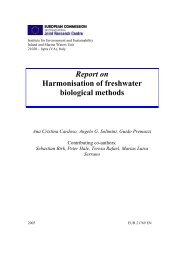Lakes and Watercourses
Lakes and Watercourses
Lakes and Watercourses
You also want an ePaper? Increase the reach of your titles
YUMPU automatically turns print PDFs into web optimized ePapers that Google loves.
Oxygen status <strong>and</strong><br />
oxygen-consuming<br />
substances<br />
Introduction<br />
Dissolved oxygen is vital for respiration <strong>and</strong> many microbial <strong>and</strong> chemical<br />
processes in the ecosystem. The concentration may thus regulate the<br />
biological structure. Oxygen conditions vary, mainly due to changing<br />
production conditions <strong>and</strong> the organic load, including natural humic<br />
substances leaching from the catchment area. In the bottom water of<br />
stratified lakes (the hypolimnion), the oxygen situation is at its worst at<br />
the end of the stagnation period in summer, at which time conditions<br />
may become critical for many organisms. The end of the period when<br />
lakes <strong>and</strong> rivers are ice-covered is another crucial time. Oxygen conditions<br />
in watercourses may be poorest at times of low flow, particularly in<br />
polluted rivers. Significant variations in oxygen levels <strong>and</strong> oxygen<br />
saturation can occur from one day to the next in the surface waters of<br />
unstratified lakes <strong>and</strong> in rivers <strong>and</strong> streams.<br />
Oxygen concentration is prefered to saturation as a means of characterising<br />
oxygen status because the thresholds of tolerance of various<br />
organisms are usually expressed as concentrations. However, merely<br />
stating the oxygen concentration may give an incomplete picture of<br />
oxygen conditions, particularly in rivers <strong>and</strong> streams. This is due to<br />
variations in oxygen input <strong>and</strong> organic load. The presence of oxygenconsuming<br />
substances should therefore also be taken into account. The<br />
concentration of organic matter provides essential information about the<br />
risk of low oxygen levels occurring between the occasions on which<br />
oxygen concentrations are monitored.<br />
A high oxygen concentration or oxygen saturation is not always a sign<br />
of a ”healthy” environment. Assimilation by plants may result in saturation<br />
figures of over 100 per cent in eutrophic waters.<br />
Scales have only been given for assessing current conditions because<br />
of the difficulties of determining reference values.<br />
Assessment of current conditions<br />
Oxygen status is assessed in the bottom waters of stratified lakes <strong>and</strong> also<br />
in the circulating water column in unstratified lakes. Annual minimum<br />
values based on concentrations monitored during critical periods (late<br />
29















![Accommodation booking form [PDF]](https://img.yumpu.com/39471785/1/184x260/accommodation-booking-form-pdf.jpg?quality=85)

